Biennial Report



On behalf of the Flathead Basin Commission (FBC), we are pleased to provide our biennial report for 2021 – 2022. The past two years have brought historical change to the Flathead Valley in the form of both long-awaited successes and new, unprecedented challenges. With the COVID-19 pandemic playing a huge role in population growth, Flathead and Ravalli became Montana’s fastest-growing counties with annual increases around 3.5% (U.S. Census Bureau). This shift bumped Kalispell up to rank as one of the fastest-growing micropolitan areas in the nation (Montana Free Press, 2022). The influx of new residents has put stress on the local infrastructure, from water to schools to outdoor recreation sites. Alongside these challenges, I—as a lifetime Montana resident—have also seen great progress in furthering protection of our natural resources, both as the Natural Resource Department Head for the Confederated Salish & Kootenai Tribes (CSKT) for the past 12 years and as the Chair of the Flathead Basin Commission. This past year CSKT celebrated the reclamation of our management of the National Bison Range after more than a century of federal management and nearly two decades of negotiations. The transfer was accomplished through enactment of the Montana Water Rights Protection Act of 2020 and was finalized in January of 2022. The restoration of the Bison Range to tribal control was the righting of a long-standing wrong and successfully returned a vital piece of our culture that had been taken from us long ago. Additionally, with the signing of the Water Rights Act, $1.9 billion in funding was authorized to CSKT for a variety of purposes, including improving the water efficiency of the Federal Flathead Indian Irrigation Project, restoring and protecting Tribal resources, and constructing and maintaining community water distribution and wastewater facilities. These advancements have partnered well with the work of FBC over the past two years, focusing on nonpoint source pollution and emphasizing the importance of coordination and communication among and between basin partners. In this biennium, the commission has received several federal grants to conduct many groundbreaking, innovative projects to address both current and emerging nonpoint source pollution issues that affect our watershed, including septic leachate and stormwater runoff pollution.
It has been an honor to serve as Chair, and I am looking forward to continuing the great work of the commission in the next two years. The work the commission is able to accomplish for the communities, citizens, and Flathead Basin as a whole is increasingly important, now more than ever, in protecting our exquisite natural resources for generations to come.
Sincerely,
Rich Janssen Jr., MBA-Chair, Department Head, Natural Resources Confederated Salish & Kootenai Tribes
Being able to work with and support the staff of the Flathead Basin Commission has been inspiring and one of the best, most impactful partnerships I have been a part of to date. The quality of work, the growth of the projects, and the extensive collaborations the Flathead Basin Commission has fostered in the past two years have been exceptional. It is an honor to be part of the team.
The Flathead Basin Commission and its staff have maximized the available resources to have the greatest impact while pushing forward innovative ways to protect the basin’s natural resources. The focus on nonpoint source pollution issues, including stormwater and septic leachate, is imperative to protect the incredible resources of the Flathead from degradation, especially considering the exponential growth the valley is experiencing.
From leading the way with a basin-wide stormwater analysis to developing a septic leachate risk model and interpretive map, the work of the commission matters. The projects are some of the first of their kind in the state in terms of breadth and impact in addition to addressing the issues from a watershed perspective. Being able to prioritize the most beneficial projects in the highest impact areas allows for a clear direction forward and ensures constructive outcomes.
Finally, the work the commission has done on the “Montana Waters: Clearly Connected” water quality campaign to engage residents and visitors alike on the difficult topic of nonpoint source pollution has been and will continue to be vital to expanding reach and promoting voluntary behavioral change to protect our water resources.
The work of the Flathead Basin Commission is actively making a difference locally and will continue to be needed as we see additional growth. The commission has laid a solid foundation and provides a clear roadmap to continue to collaboratively protect the basin’s natural resources for years to come. I am proud to be part of the commission and look forward to seeing our future accomplishments together.
Sincerely,
Casey Lewis, Vice-Chair Environmental Coordinator, City of Kalispell
Serving as Executive Director for the Flathead Basin Commission for the past five years has been a stimulating and exciting challenge. We have not only reshaped and rejuvenated this unique, partnership-focused organization but expanded and improved our community engagement and stakeholder relationships while embarking upon exciting and innovative new projects in a time that our watershed is seeing unprecedented population growth and rapidly increasing development. Returning to our original water quality focus, FBC has prioritized nonpoint source pollution with a specific focus on septic leachate and stormwater pollution. In the past two years, we have increased and secured our state operating funds, hired a new (and fantastic) Nonpoint Source Coordinator, Emilie Henry, developed and launched the “Montana Waters: Clearly Connected” education and outreach campaign, and implemented several groundbreaking projects including the completion of our GIS Septic Risk Model, a synthetic DNA tracer study, and the publishing of our basin-wide stormwater infrastructure inventory.
I would like to thank all the commission members (including the long haulers, those who have moved on and those who have joined us in the past two years), as well as our many new and long-standing partners. Your participation and coordination make all of our work, programs, and projects possible. We are pleased to welcome several new members who have been appointed by Montana’s governor, Greg Gianforte, including Sandy Beder-Miller and Brian Hughes, representing industry, environment, and other interests; Mike Freeman, Natural Resource Policy Advisor to Governor Gianforte; Steve Stanley, Lake County Commissioner; and Dave Roemer, Glacier National Park. In addition, we have a couple new ex-officio representatives including Peter Brumm, U.S. EPA, and Bill Dykes, Bureau of Reclamation.
In the next two years, our vision is to continue to tackle complex aquatic and natural resource issues, while also increasing public and stakeholder participation in meetings, projects, and committees. We have a lot of work to do, but a bright and promising future of protecting the quality of life, cultural diversity, and economic and ecological integrity of the basin is ahead of us. I’ve been honored to facilitate these efforts on behalf of the commission. This report provides highlights of our accomplishments, projects, sources of funding, and expenditures for the fiscal years 2021 and 2022.
Finally, this will be my last report as Executive Director. I have accepted a position as Montana Liaison with the Bonneville Power Administration and will be starting very soon. I hope our paths cross along other avenues in the future. And please keep up the great work, continuing to protect this water-rich basin in all its splendor, connection, and wildness.
Cheers!
Kate Wilson, Executive Director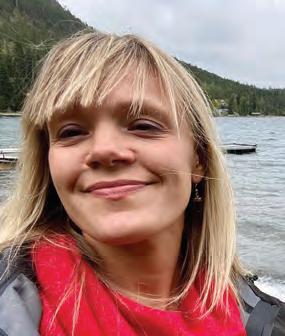 Montana Department of Natural Resources & Conservation (DNRC)
Montana Department of Natural Resources & Conservation (DNRC)
Flathead
Upper
Basin Commission Columbia Conservation Commission (UC3)Cassidy Bender
Commission Coordinator
Montana Department of Natural Resources & Conservation – Flathead Basin Commission/Upper Columbia Conservation Commission - Staff
Emilie Henry

Nonpoint Source Coordinator
Montana Department of Natural Resources & Conservation – Flathead Basin Commission - Staff
Randy Brodehl

Flathead County Commissioner
Voting Member (Kalispell)
Lech Naumovich
Supervisor
Flathead Conservation District Voting Member (Kalispell)
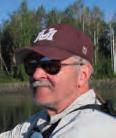



Jasmine Courville-Brown
Governor Appointed
Confederated Salish & Kootenai Tribes Voting Member (Ronan)


Kathy Olsen
Water Resources Regional Manager
Montana Department of Natural Resources & Conservation Voting Member (Kalispell)
Sandy Beder-Miller

Governor Appointed
Voting Member (Yaak)
Mike Freeman
Natural Resource Policy Advisor
Office of Governor Greg Gianforte Voting Member (Helena)
Jack Potter
Governor Appointed
Voting Member (Columbia Falls)
Brian Hughes

Governor Appointed
Voting Member (Lakeside)
Steve Stanley
Lake County Commissioner
Voting Member (St. Ignatius)
Jim Simpson Supervisor

Lake County Conservation District Voting Member (Polson)




Kurt Steele
Flathead National Forest Supervisor

United States Forest Service Voting Member (Kalispell)

Dave Roemer
Glacier National Park Superintendent
National Park Service Voting Member (West Glacier)
Mark Bostrom Conservation & Resource Development


Division Administrator
Montana Department of Natural Resources & Conservation Ex-Officio (Helena)
Myla Kelly
Water Quality Standards Section Supervisor
Montana Department of Environmental Quality Ex-Officio (Helena)
Jim Williams
Region 1 Supervisor
Montana Department of Fish, Wildlife & Parks Ex-Officio (Kalispell)
Mark Reller

Montana State Liaison
Bonneville Power Administration Ex-Officio (Helena)
Bill Dykes
Hungry Horse Field Office Manager
United States Bureau of Reclamation
Ex-Officio (Hungry Horse)
Peter Brumm
Hydrologist & TMDL Coordinator
United States Environmental Protection Agency Ex-Officio (Helena)

Headwaters of the Columbia River, the Flathead Basin comprises 6 million acres of lush forests, productive agricultural lands, and vibrant towns. The three forks of the Flathead River, which have the Wild and Scenic River designation, flow into Flathead Lake, the largest natural freshwater lake west of the Mississippi. The Flathead Basin serves a critical ecological role, providing habitat to important native species, such as grizzly bears and westslope cutthroat trout.
While Flathead Lake is considered to be oligotrophic (lacking in plant nutrients), decreases in water quality have led the U.S. Environmental Protection Agency and Montana Department of Environmental Quality to categorize it as “impaired” for nitrogen, mercury, phosphorus, and polychlorinated biphenyls (PCBs). Given the connectivity and nature of water, the activities in the Flathead Basin are of major interest to downstream states, tribes, and other partners.
As a result of the COVID-19 pandemic, the Flathead Basin experienced (and continues to experience) unprecedented growth as more and more people seek refuge from densely populated areas in the Montana wilderness. According to the U.S. Census Bureau, Flathead County added 3,681 people between July 1, 2020, and July 1, 2021. That’s a growth rate of 3.5%, making the Flathead area the fastest growing micropolitan region in the nation. As tourism and population rates in northwest Montana increase, the pristine waters and exquisite natural resources of the Flathead Basin are seeing unprecedented amounts of recreational use, growth, and development, making their protection and conservation even more urgent.
The purpose of the Flathead Basin Commission is to protect the existing high quality of the Flathead Lake aquatic environment; the waters that flow into, out of, or are tributary to the lake; and the natural resources and environment of the Flathead Basin.
The Flathead Basin Commission (FBC) was created in 1983 by the Montana Legislature (MCA 75-7-301-308) to monitor and protect water quality and natural resources in one of the state’s most important watersheds. FBC is a uniquely structured non-regulatory organization that works to accomplish its important mandate in a consensus-building manner, stressing education, cooperation, broad-based community involvement, partnerships with agencies and nonprofit groups, and the voluntary participation of basin residents. Consistent with the duties of the commission as stated in the establishing statute the commission considers its role in the basin to:
• Coordinate water quality protection and monitoring activities
• Work with our partners to ensure water quality, economic, land use, and natural resource data is gathered, analyzed, interpreted, and disseminated to the public and responsible agencies
• Facilitate policies and actions that have a positive result on water quality and natural resources
• Provide leadership in making the case for basin water quality and protection of its natural resources
The 20-member commission represents a wide cross-section of citizens and local, state, tribal, and federal agency representatives who strive to identify the basin’s water quality problems and work collectively to implement the most effective solutions. The agency members of the commission are prescribed in statute; the governor appointed members are selected for four-year staggered terms.
The Flathead Basin Commission has become a model of successful citizen and interagency cooperation in a geographically vast and ecologically diverse watershed characterized by its overall pristine character, international dimension, and multijurisdictional nature.
This biennial report summarizes FBC’s activities and initiatives in the 2021 – 2022 fiscal years. More information on FBC, including updates on activities, basin water-quality issues, and FBC’s establishing legislation is available on our website (https:// flatheadbasincommission.org/).
FBC has tackled many issues and projects in the past two years. Since our last report, meetings have been held in the following locations across the basin:
FBC Meetings
• July 8, 2020 (virtual due to COVID-19)
• September 23, 2020 (virtual due to COVID-19)
• January 19, 2021 (virtual due to COVID-19)
• March 31, 2021 (virtual due to COVID-19)
• September 8, 2021 (Polson, MT)
• March 2, 2022 (Kalispell, MT)
• May 11 – 12, 2022 (Whitefish, MT)
We have strong leadership on our executive committee, dedicated commission members, excellent staff support, and a community of highly engaged watershed partners.
We have access to technology and communications tools that allow us to work efficiently and effectively.
We have worked hard to deepen and improve our community presence and stakeholder relationships by being civicminded, sharing our knowledge and resources widely, and acknowledging and engaging all entities addressing water quality issues within the Flathead Basin.
The list of organizations working with FBC is long and diverse, including academia, researchers, scientists, agencies, policymakers, and community stakeholders. We continue to engage existing partners and encourage new partnerships to share in our efforts to protect water quality in the Flathead Basin.

While the commission tracks and follows all natural resource issues and emerging threats to the basin, the primary area of focus has been on nonpoint source (NPS) pollution with an emphasis on septic leachate and stormwater runoff. The following strategic priorities are divided into categories based on the commission’s mission and duties outlined in statute as well as roles and responsibilities to date. These priorities and actions were established at a strategic planning meeting (May 2022 in Whitefish) to provide direction for staff and to focus commission efforts for a three-year period (2022 – 2025)
• Track, monitor, research and investigate existing condition and utilization of resources, emerging threats and science, and best management practices for advancing natural resource protection efforts in the basin
• Work with partners to build support for, develop, and implement on-theground projects to investigate and address nonpoint source pollution in the Flathead Basin
• Explore and advocate for approaches/options to address NPS pollution, including increasing funding opportunities and incentives, encouraging sustainable development, successfully implementing current water quality standards, etc.
• Provide support/forum for addressing any gaps or resource needs in longterm water quality monitoring, septic leachate, and stormwater pollution mitigation, etc
• Increase public awareness of water quality issues threatening the pristine water quality of the Flathead Basin
• Enhance personal behaviors and inspire residents and visitors to take pride and responsibility in conservation efforts
• Increase consistency of messaging among partners, improve accessibility and awareness of available resources, and enhance partnership opportunities
• Provide leadership and support on public, youth and stakeholder engagement with natural resource/community events, activities, and issues within the basin/region
• Encourage close cooperation and coordination between federal, state, provincial, tribal, and local resource managers for establishment of compatible resource development standards, comprehensive monitoring, and data collection, and interpretation
• Coordinate with local leaders, organizations, and industry within the basin/region on key natural resource issues to increase support and leadership for advancing protections
• Provide complementary support to partner programs and projects while emphasizing appreciation and recognizing exemplary efforts in the basin
• Provide a cooperative, inclusive, and open environment to promote coordination and act as a public forum for addressing issues and existing gaps
• Ensure regular communication with decision-makers, local partners, and stakeholders on the efforts of FBC
• Provide input, feedback, and recommendations to the governor and to federal and state agency directors and staff, tribal, provincial, regional, and local agencies for reducing the threats to water quality
• Track, advocate for, and seek to address water quality gaps and challenges in the Flathead Basin as well as transboundary and headwaters protection efforts
• Coordinate with legislators within the basin/region on key natural resource issues to increase support and leadership for advancing protections
• Ensure regular communication with decision-makers, congressional, and state legislators on the efforts of FBC and provide a regular presence at events, activities, and legislative sessions
• Develop biennial report (per statutory duties)
• Provide accounting and budgeting services
• Follow all applicable agency and board rules and requirements
• Explore options for additional funding
Onsite Wastewater Treatment Committee
Chair: Mike Koopal (Whitefish Lake Institute)
Vice-Chair: Ryan Richardson (River Design Group)
Committee Members:
Casey Lewis (FBC/City of Kalispell), Abigail St. Lawrence (MT Building Industry Association), Andy Crites (Attorney), Tom Bansak (Flathead Lake Biological Station), Dean Sirucek (Retired Soil Scientist), Craig Kendall (U.S. Forest Service), Diana Luke (Lake County Sanitarian), Eric Bryson (MT Association of Counties), Eric Regensburger (Dept. of Environmental Quality), Eric Trum (Dept. of Environmental Quality), Meagan Gilmore (Dept. of Environmental Quality), Sam Sill/Erica Wirtala (MT Association of Realtors), Evan Smith (Confederated Salish & Kootenai Tribes), Representative Dave Fern, Samantha Tappenbeck (Flathead Conservation District), Hilary Devlin (Flathead Lakers), Kate Sheridan (Flathead Lakers), Lamont Kincaide (MT Water Specialists), Roger Noble (Flathead County Health Board), Steve Rosso (Flathead Lakers), Susie Turner (City of Kalispell), Tim Burton (MT League of Cities & Towns), Jim Baker (Friends of Lake Mary Ronan), Daniel Congdon (Dept. of Environmental Quality), Tom Cowan (Retired Engineer/Sanitarian), Tom Cox (Flathead Lakers), Peter Brumm (Environmental Protection Agency), Sam Bourret (MT Fish, Wildlife & Parks), Jeff Tuttle (Flathead Lakers), Heidi Fleury (Lake County Conservation District), Kristal Kiel (Flathead City-County Health Dept.), Karin Hilding (City of Whitefish), FBC staff
Adopt a shared strategy and develop options through a collaborative process to protect public health and water quality from septic leachate in the Flathead Basin by increasing onsite wastewater treatment systems performance.
1. Increase participant knowledge of existing standards and processes for onsite wastewater systems in Montana and in other jurisdictions
2. Work with, seek feedback from, and make tools available to all local governing bodies, regulators, community groups, and health departments in the basin
3. Participate in and/or make recommendations to appropriate audiences as needed: i.e., state legislature, local government, and/or partners (DEQ, DNRC, City of Kalispell, City of Whitefish, etc.) for effective onsite wastewater treatment systems and management
4. Identify any knowledge gaps, data needs, and/or barriers to onsite wastewater system processes, implementation, and functionality
5. Explore options for increasing performance and sustainability of onsite wastewater treatment systems in the state via standards, incentives, and funding opportunities
6. Identify emerging solutions and appropriate compliance mechanisms
7. Develop and provide report with recommendations for approaches or actions related to onsite wastewater treatment systems to the Flathead Basin Commission for consideration
8. Encourage the Flathead Basin Commission to provide public forum on committee findings and recommendation(s)
9. Seek more information on septage/land application requirements and practices. Ensure that any proposed recommendations acknowledge/address any potential septage issues.

Co-Chairs: Casey Lewis (City of Kalispell) and Lech Naumovich (Flathead Conservation District)
Committee Members: Tom Bansak (Flathead Lake Biological Station), Ian Withrow (Flathead Lake Biological Station), Samantha Tappenbeck (Flathead Conservation District), Kate Sheridan (Flathead Lakers), Cynthia Ingelfinger (Whitefish Lake Institute), Sheena Pate (Flathead Rivers Alliance), Evan Smith (Confederated Salish & Kootenai Tribes), Eric Trum (Dept. of Environmental Quality), Meagan Gilmore (Dept. of Environmental Quality), Heidi Fleury (Lake County Conservation District), FBC staff
Committee Purpose:
Increase public awareness of water quality issues threatening the pristine water quality of the Flathead Basin, ultimately enhancing personal behaviors and inspiring residents and visitors to take pride and responsibility in conservation efforts. Increase coordination and collaboration with partners working on water quality issues in the Flathead Basin by increasing consistency of messaging, improving accessibility and awareness of available resources, and enhancing partnership opportunities.
Committee Objectives:
1. Develop and implement an “umbrella” water quality education and outreach campaign that can be utilized and adapted by partners throughout the Flathead Basin to inform the public on various water quality issues.
2. Create a website to house campaign materials and act as a “hub” of information and resources for various water quality issues.
3. Identify and address gaps in current education, outreach, and advertising efforts in the basin.
4. Work with partners to conduct outreach on campaign/ local programs, disseminate materials, engage business community and local government (emphasize economic benefit of protecting water quality), etc.
Chair: Mike Koopal (Whitefish Lake Institute)

Vice-Chair: Ryan Richardson (River Design Group)
Core Team: Myla Kelly (Dept. of Environmental Quality), Tom Bansak (Flathead Lake Biological Station), Sam Bourret (MT Fish, Wildlife & Parks), Rachel Malison (Flathead Lake Biological Station), FBC staff, supplemental members (based on project/need)
Committee Purpose: Provide support and inform specific natural resource projects in the basin with technical knowledge and experience. The “core team” is comprised of FBC members, staff, and partners, and additional experts are added/requested as needed to support specific projects. Currently, projects include septic leachate, stormwater, and water quality monitoring.
Committee Objectives:
1. Provide technical support and information to inform and move forward FBC projects.
2. Assist with locating literature, reports, and other technical or relevant information.
3. Review and provide feedback on contracts, project plans, budgets, and timelines.
4. Utilize networks to assist with specific project needs.

The Flathead Basin is home to large clear lakes, clean cold rivers, and extensive groundwater resources that support our economy, promote robust ecological benefits and environmental services, and provide vast recreational opportunities to our community. Nonpoint source (NPS) pollution is the leading cause of water quality issues in the United States and Montana (U.S. EPA). NPS pollution originates from sources that are difficult to pinpoint and are spread through runoff, precipitation, drainage, atmospheric deposition, or seepage. The water transports natural and human-made pollutants, depositing them into lakes, rivers, wetlands, and aquifers. Sources of NPS pollution include excess fertilizers, pesticides, oil, excess sediment, salts, as well as bacteria and nutrients from livestock and septic systems. In excess, these pollutants have significant harmful effects on drinking water supplies, recreation, fisheries, and wildlife in the Flathead Watershed. According to the Montana Department of Environmental Quality, NPS pollution is the largest contributor to water quality problems on a statewide basis. FBC has prioritized NPS issues in their strategic plan since 2019, specifically focusing on septic leachate and stormwater.
After solids separate from wastewater in a septic tank, the remaining liquid, known as septic leachate, is released into the ground by the drain field. Septic systems require regular maintenance to function effectively and have an average lifespan of 20 to 30 years before they should be replaced. Septic leachate can carry pollutants such as nutrients and pathogens and may transport them to groundwater or surface waterbodies.
Excess nutrients in surface water can cause harmful algal blooms that reduce oxygen, facilitate growth of nuisance aquatic plants, harm wildlife, and make recreation difficult or unpleasant. Disease causing pathogens can make their way into drinking water and harm community health.

• Over half of homes on Flathead Lake are on private septic systems.
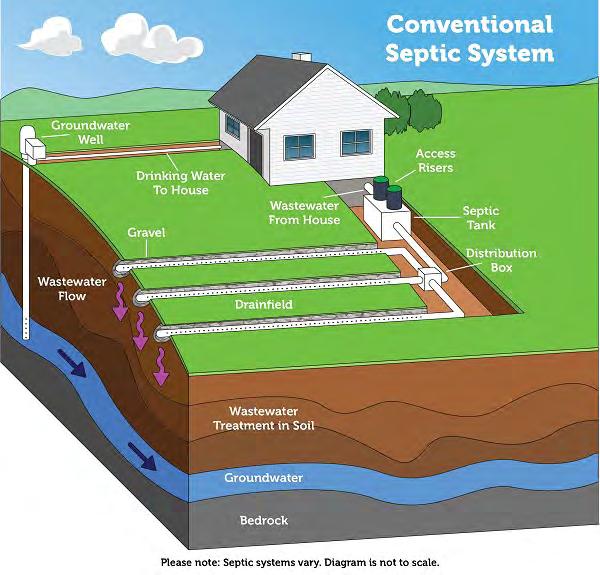
• An estimated 10% of septic systems near Whitefish Lake are underperforming.
• As of 2020, more than 50% of septic systems in Flathead County were over 20 years old.
• There are no state, county, or tribal regulations requiring maintenance or inspection after a septic system is installed in the basin.
Septic leachate has been identified as a risk to water bodies in the Flathead Basin and has been welldocumented with studies dating back to the 1970s. Onsite wastewater treatment systems (otherwise known as septic systems) can achieve satisfactory wastewater treatment if they are properly planned, designed, sited, installed, operated, and maintained. However, underperforming septic systems are a relatively newly recognized and serious contributor to the nation’s unaddressed water pollution problem. Septic systems that are sited in densities that exceed the treatment capacity of regional soils and systems that are outdated or poorly designed, installed, operated, or maintained can pollute water resources and may lead to toxic and harmful algal blooms.
FBC formed the Onsite Wastewater Treatment Committee in 2019 to address the challenges septic leachate poses to water quality and public health. The Committee is comprised of interested commission members, partners, and concerned citizens. Since the inception of this committee, FBC has been able to further investigate the septic leachate problem in the Flathead Basin through a committee solutions survey, a basin-wide GIS-based septic risk assessment, a synthetic DNA tracer study, and many other projects aimed to contextualize the septic leachate issue, pursue solutions, and inform the public.
In early 2020, FBC staff circulated a survey to members of the Onsite Wastewater Treatment Committee and stakeholders to solicit feedback on specific recommendations and approaches that would be the most effective and/or feasible in the Flathead Basin for addressing septic leachate issues. Survey participants (n=19) were asked to provide thoughts on many different approaches, which included regulatory change, funding/incentives, providing municipalities/counties support, and education and outreach options. They were then asked to rank the approaches in order of importance/feasibility. The top approaches and their ranking by survey participants are shown in Figure 1 and outlined in detail in the following list. The survey results helped staff gauge interest and gather feedback on approaches that have been identified by the committee to date, and all options will be considered for future action/recommendation by the committee and FBC.
1. Require inspection and disclosure of septic system presence/status prior to property sale
2. Require permitting decisions based on location of request compared to the GIS septic risk map
3. Develop model regulation with higher standards for counties to adopt
4. Develop model regulation with resource manual and reference for planning to better address septic issue and allow for site specific treatments county or basin-wide
5. Increase septic system setbacks from surface water
6. Systems of a certain age and/or developed metrics to trigger mandatory testing and/or investigation of leachate source(s)
7. Provide counties with authority and enhanced oversight to better address grandfathered systems (prior to 1978 MT permitting requirement)
8. Provide authority for counties to investigate septic issues (beyond tank) including but not limited to mandatory dye testing for older and/or potentially underperforming systems
9. Increase grants and/or loans available for private landowners to maintain or replace septic systems
10. Provide support and/or incentives for expenses related to replacement or connection to sewer for subdivisions and mobile home communities, especially in high-priority areas
11. Increase funding for enforcement and compliance (and develop mechanism to capture funding)
12. Provide incentives for higher/enhanced treatment options
13. Develop/provide standards and guidance on testing/methods for determining sources of septic leachate pollution
14. Update and disseminate messaging about septic system health and maintenance
15. Increase training opportunities for inspectors, installers, real estate agents and elected officials
16. Develop broad water quality campaign that can target nonpoint source pollution issues
17. Develop DNRC policy for septic systems on state-owned land
To better understand the scope of the septic leachate problem in the basin, FBC’s Onsite Wastewater Treatment Committee identified a need to map the spatial distribution and scale of the septic leachate problem in the basin. The team initiated a contract with River Design Group in 2020 to develop a model of septic risk for the watershed. The process began with mapping known geophysical risk factors for septic system underperformance, including soil type, slope, depth to groundwater, and proximity to surface water. These individual risk factors were combined to create cumulative physical risk models for both Flathead and Lake Counties (Fig. 2.1 and 2.2). The team then incorporated the age and density of existing
septic systems to highlight areas with the highest risk of septic system underperformance (Fig. 3). FBC is working with partners to add the southern basin to the existing risk model. A draft report summarizing model development and results is available and will be published following external review.


FBC staff and committee members presented the septic models to planners, decision-makers, politicians, and municipal, county, and tribal staff throughout the basin. The models were introduced as tools that can be used to inform development decisions. FBC staff is working on developing an online, interactive version of the models that will be available to the public.



The biggest limitation to the septic risk analysis in Flathead County was the lack of data prior to the permitting requirement enacted in 1978, meaning that any systems installed before 1978 would not have an associated permit in Flathead County’s database. To understand how many unpermitted systems may be in place, our team conducted an analysis and utilized an accompanying survey. First, cadastral data was used to identify parcels that likely have a septic system, but no permit based on tax-assessed value, size of property, and ownership information. Approximately 8,000 parcels in Flathead County were identified through this analysis (Fig. 4).


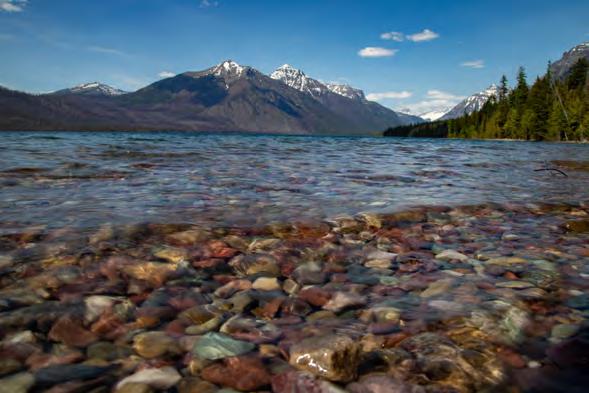

To ground-truth the findings, we sent a postcard survey (Fig. 5) to all 8,000 parcels asking if they have a septic system at their address. Of the survey respondents (n=192), 72% confirmed the presence of a septic system at their address, indicating that Flathead County likely contains ~5,000 unpermitted septic systems.

To validate the results of the septic risk models, the committee recommended conducting a synthetic DNA tracer study to track leachate from specific septic systems. Synthetic DNA are short, unique strands of lab-created DNA that are encased in a biodegradable polymer. The tracers are flushed down the toilets of homeowners who live in close proximity to surface water, and nearshore samples are collected and analyzed to see if tracers are present. Each participating homeowner gets a unique tracer that acts as a barcode for their septic system.
The pilot study began in the spring of 2022 on Whitefish Lake and Lake Mary Ronan because areas surrounding both lakes were found to be high risk according to the septic risk models. Eight homeowners on both lakes agreed to participate, and a groundwater flow and nitrogen plume models were used to determine nearshore sampling


locations. Tracers were deployed in the spring, and nearshore samples were collected by staff and volunteers regularly through October.
The results of this study are being analyzed and will inform if similar tracer studies in the basin should be performed. This technology has not been studied before in our ecoregion, so if successful, we would have another tool in our toolbox to better understand septic leachate in the Flathead Watershed. The committee will continue to assess all means of addressing this issue, including but not limited to regulatory modifications, funding and incentives, enhancing training opportunities, and targeted outreach.






FBC, partnering with the City of Kalispell, initiated a series of projects in 2020 assessing and addressing stormwater in the basin. Stormwater is runoff from hard surfaces that can mobilize pollutants on the landscape. Here in the Flathead Basin, most stormwater flows directly into surface water without any treatment.

In 2020, Emilie Henry, former Big Sky Watershed Corps (AmeriCorps) member now FBC Nonpoint Source Coordinator, compiled an inventory of stormwater infrastructure in the basin and developed a model for prioritizing areas of the watershed at the highest risk for stormwater pollution. During her second term, Emilie created a roadmap for future FBC stormwater work. This plan includes continuing to monitor stormwater runoff for pollutants, working with owners of stormwater infrastructure to increase capacity for effective management and maintenance, and developing a campaign for incentivizing sustainable, infiltration-based stormwater alternatives in new development. FBC will host another Big Sky Watershed Corps member in 2023 to continue this work.
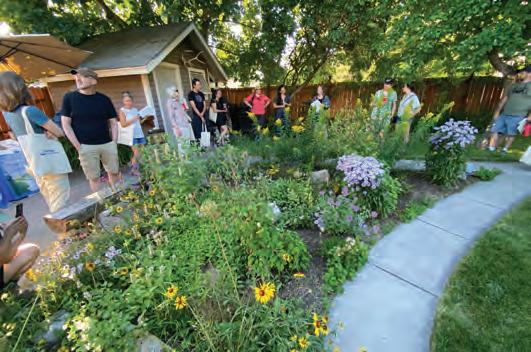


FBC continues to support the Flathead Rain Garden Initiative (FRGI), a collaboration between the City of Kalispell, the Flathead Conservation District, and FBC. The goal of the FRGI is to empower residents of Flathead County to build rain gardens on their property by providing technical and financial support. Rain gardens are landscaped depressions that capture, filter, and absorb stormwater runoff while providing pollinator habitat and reducing flooding and erosion risks.
In July 2022, the program hosted a walking tour of five gardens in downtown Kalispell. Attendees heard from program participants about their motivations and some successes and challenges they experienced building their gardens. To date, the program has helped 17 homeowners build 19 rain gardens in Flathead County that collectively manage over 200,000 gallons of runoff every year!
Assisted 17 homeowners
To build
19 rain gardens
In 2022, the City of Kalispell and FBC launched an Adopta-Drain campaign. The program encourages residents of Kalispell to become a steward to a storm drain in their neighborhood, regularly sweeping away trash and debris that may have accumulated on it. The program provides volunteers with a free toolkit containing a broom, dustpan, safety vest, gloves, trash bags, and a yard sign to spread the word. Scan QR code to watch a video and learn more about the Adopt-a-Drain program.


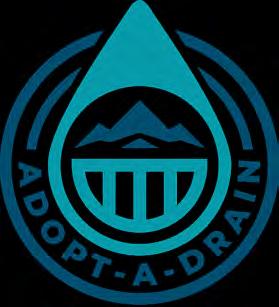
Within just a short time of launching the program, there are already 17 storm drains adopted, six cleanings reported, and 10 volunteers.
6 Cleanings Reported
17 Storm Drains Adopted
Scan QR code to watch a video and learn more about the Adopt-a-Drain program!
10 Volunteers

FBC has been working on various water quality issues including nonpoint source pollution focused projects such as septic leachate and stormwater pollution/mitigation. After discussing ways to conduct outreach on several of these projects, the commission identified the need for a comprehensive, partner-driven water quality campaign for the Flathead Basin. Although there are many local and state organizations making great progress on protecting the existing high quality of Northwest Montana’s most vital resource, water, there is a lack of wide-reaching public engagement and education efforts surrounding water quality and nonpoint source issues.
In December of 2020, FBC hosted a meeting of 50+ partners and partner organizations working on these water quality issues throughout the Flathead Basin. The meeting and a follow-up survey gathered valuable feedback about our partners key issues, values, and priorities, gauging interest on the need/desire for a larger water quality focused partnership campaign. Using this feedback, the Flathead Basin Commission created an innovative
“umbrella” education and outreach campaign to engage the public on many different complex water quality issues including stormwater pollution, septic leachate, and much more. “Montana Waters: Clearly Connected” is an initiative aimed at bringing partners together with coordinated messages, usable resources, and a centralized hub of information. The creation, development, and evolution of this campaign relies heavily on partnerships, both for effectively leveraging resources and extending outreach beyond the scope of any one organization, in order to collectively protect our abundant and beautiful Montana waters.

During the creation of the campaign, the commission formed an Education & Outreach Committee to assist and provide more in-depth discussion and guidance in the development of the “Montana Waters: Clearly Connected” campaign and subsequent projects. With the influx of new residents to the basin in the past two years, one of the biggest needs identified among partners was a comprehensive collection of information for new


homeowners and landowners in our watershed. In FY22, FBC dedicated a portion of their operating funds to assist the Flathead Lakers and other partners in the creation and development of the “Living in the Flathead Guide.” Aimed to be published and printed in 2023, this guide will provide homeowners with important information on how to live sustainably in a watershed with increasing water quality issues, wildlife, wildfires, and much more.
With the addition of staff and the increased capacity provided by the Big Sky Watershed Corps programs, FBC was able to engage with the community more frequently at several outreach events over the past two years. including the Flathead Family Forestry Expo, Northwest Montana Fair & Rodeo, Community Pump Party: Septic Education,
Western States Water Council, Montana Stormwater Conference, and more.

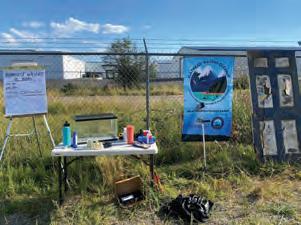
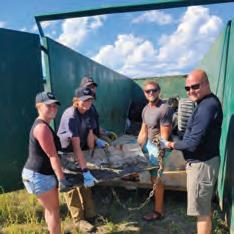
In August 2021, FBC, the Flathead Conservation District, and other partners co-hosted the inaugural Flathead Waters Cleanup event. The goal was to encourage volunteers to clean up trash and debris in and around the waterbodies of the Flathead Basin. Volunteers were invited to an afterparty at Sacred Waters Brewing Company to dispose and weigh their trash and to qualify for amazing prizes donated by community sponsors. In 2021 and 2022, the event engaged a total of 411 volunteers who helped to remove over 7,700 pounds of trash and improve almost 300 miles of riverbank and lakeshore across the watershed. The event garnered tremendous community support and has become a tradition in the Flathead.


Engaged volunteers
Removed over pounds of trash
300
411 7,700 Improved miles of riverbank & lakeshore
As tourism and population rates in northwest Montana rapidly increase, the pristine waters and exquisite natural resources of the Flathead Basin are seeing unprecedented amounts of recreational use, growth, and development. Although there are many local and state organizations that are making great progress on protecting the existing high quality of Northwest Montana’s most vital resource—water—there is a lack of wide-reaching public engagement and education efforts surrounding water quality and nonpoint source issues. Working with 50+ partner organizations, the Flathead Basin Commission created an innovative "umbrella" education and outreach campaign to engage the public on many different complex water quality issues, including stormwater pollution, septic leachate, and much more.
Montana Waters: Clearly Connected is an outreach initiative aimed at bringing partners together with coordinated messages, usable resources, and a centralized hub of information. The creation, development, and evolution of this campaign relies heavily on partnerships, both for effectively leveraging resources and extending outreach beyond the scope of any one organization, in order to collectively protect our abundant and beautiful Montana waters.

Water is perhaps the most vital, valuable natural resource; it is the natural element that connects all people, places, and living things in Montana. Flowing over borders, across state boundaries, and transcending human-made divides, water bonds mountaintops to riverbeds, connects cities upstream with communities downstream, and provides the link between our generation and all generations to come.
1 2 3 4
Expand public knowledge & awareness of water quality issues
Increase coordination with watershed partners by increasing consistency of messaging, improving accessibility and awareness of available resources, and enhancing partnership opportunities
Partners
• Federal Agencies
• State Agencies
• Tribal Governments
• Local Governments
• Nonprofits
• Local Watershed Organizations
• Citizens
Audiences
• Water Recreators
• General Water Users/Public
• Neighborhood Associations
• Building & Realtor Associations
• Legislators & Policymakers
• Partner Organizations
• and more
Inspire residents and visitors to take pride and responsibility in conservation efforts
Encourage individual and societal behavior change
Campaign Products
• Educational materials
• Public Service Announcements
• Stickers, magnets, promotional
• items, infographics, etc.
• Print & digital advertisements
• Toolkits for different target audiences
Water Quality Issues
• Septic Leachate Pollution
• Stormwater Pollution
• Agricultural Runoff
• Shoreline Erosion
• Riparian Degradation
• Nutrient Pollution
• and more
Top 10 Things You Can Do To Protect Water Quality
We all live in a watershed and every choice we make has an impact on our water. When each of us plays our part, one action at a time, we have the collective power to protect and preserve our beautiful, pristine waters for generations to come.

11 2 2 3 3 4 4 5 5 6 6 7 7 8 8 9 9
1 2 3 4 5
Protect wetlands and riparian habitat with watershed-friendly lawn and garden tips like applying fertilizers and pesticides sparingly, avoid mowing along the water’s edge, and planting a diversity of native, deep-rooted vegetation.
Learn about and maintain your septic system with annual inspections and pumping as needed.
Install a rain garden on your property to filter oil, grease, and other pollutants from driveways, roofs, and lawns before they reach groundwater or the storm drain, where they eventually discharge into streams, rivers, and lakes.
Install a rain garden on your property to filter oil, grease, and other pollutants.
Recreate responsibly by 1) following leave no trace principles; 2) clean, drain, and dry watercraft; and 3) reduce boat wakes when engaging in water sports.
Use and dispose of hazardous materials properly and never dump anything in a storm drain. Report to your local public works department if you see dumping. Stormwater runoff enters the storm drain system, and discharges untreated into creeks, lakes, and rivers.
Dispose of hazardous materials properly and never dump anything in a storm drain.
Promptly clean up and dispose of pet waste. When pet waste is left on the ground in public or at home, bacteria and excess nutrients can wash into storm drains and eventually into local waterbodies causing health risks to the public and aquatic life.
Encourage responsible and sustainable development in your local community.
Use a commercial car wash to wash your vehicles and other equipment, where the wash water drains to the sanitary sewer. Dirty car wash water often contains oil, grease, and toxic metals that are harmful to fish and other aquatic life.
Promptly clean up and dispose of pet waste.
Get involved with local volunteer opportunities like trash clean ups, river restoration projects, citizen science initiatives, and more.
Maintain your septic system with annual inspections and pumping as needed. Septic systems that are properly planned, installed, and maintained can achieve wastewater treatment. However, systems that are outdated or poorly designed, installed, or maintained can pollute local waterbodies.

Use a commercial car wash to wash your vehicles and other equipment.
Recreate responsibly by 1) following leave no trace principles, 2) ensuring your watercraft/gear are cleaned, drained, and dried to prevent the spread of invasive species, and 3) reducing boat wakes when engaging in water sports to prevent increased shoreline erosion.
Encourage responsible development in your local community by building in upland areas where the groundwater is not shallow and limiting the density of development, including paved areas, over the aquifer.
Share what you have learned with your friends, family, and neighbors! FlatheadBasinCommission.org 27

FBC plays a vital role in coordination and collaboration throughout the Flathead Basin and has prioritized the following strategic actions to fulfill this role:
• Encourage close cooperation and coordination between federal, state, provincial, tribal, and local resource managers for establishment of compatible resource development standards, comprehensive monitoring, and data collection and interpretation
• Coordinate with local leaders, organizations, and industry within the basin/region on key natural resource issues to increase support and leadership for advancing natural resource protections
• Provide complementary support to partner programs and projects while emphasizing appreciation and recognizing exemplary efforts in the basin
• Provide a cooperative, inclusive, and open environment to promote coordination and act as a public forum for addressing issues and existing gaps
• Ensure regular communication with decisionmakers, local partners, and stakeholders on the efforts of FBC
In the past two years, we have brought together diverse groups of representatives to inform the commission, partners, and the public in the form of panel presentations at our quarterly meetings. Topics for these panel presentations included water quality monitoring, watershed conservation organizations and their projects, emergency response and preparedness, and growth and development in the Flathead Basin.

In addition to these activities, FBC provides support to partner programs and projects in the form of funding, outreach, and capacity. Among these programs is the Flathead Wastewater Partnership, which was formed to enhance coordination between various partners in the basin on septic leachate and share a Big Sky Watershed Corps member to assist with the development and implementation of a Septic Maintenance Reimbursement Program. Originally funded by a 319 grant and continued by a contribution of FBC operating funds, the reimbursement program is led by the Lake County Conservation District and provides landowners 50% (up to $200) reimbursement for maintenance of their septic systems, including pumping and inspections. This program has not only provided hundreds of residents reimbursement for maintenance of their septic systems but also expanded public awareness and knowledge of the importance of properly operating systems and the impact they may have on local water quality.


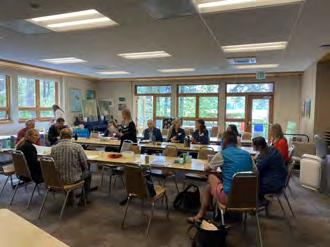
Create a publicly-accessible database with digitized septic permit data that could be adopted statewide
Create a publicly-accessible database with digitized septic permit data that could be adopted statewide
Create a publicly-accessible database with digitized septic permit data that could be adopted statewide
Support/advocate for Flathead County's Septage Biosolids & Composting Facility
Support/advocate for Flathead County's Septage Biosolids & Composting Facility
Support/advocate for Flathead County's Septage Biosolids & Composting Facility
• Host remote sensing workshop to explore technologies that MT can implement
Utilize existing tools to implement a community/citizen science program and create accompanying guide for understanding/interpreting data.
Utilize existing tools to implement a community/citizen science program and create accompanying guide for understanding/interpreting data.
Utilize existing tools to implement a community/citizen science program and create accompanying guide for understanding/interpreting data.
• Support/advocate for Flathead County's Septage Biosolids & Composting Facility
Provide support for counties and water & sewer districts.
Provide support for counties and water & sewer districts.
Provide support for counties and water & sewer districts.
• Map groundwater flows to identify target locations for more extensive sampling
Refine definition of a “failing” system at the state level.
Refine definition of a “failing” system at the state level.
Refine definition of a “failing” system at the state level.
• Develop long-term, nearshore monitoring program on which short-term, localized tracer data can be superimposed
• Utilize existing tools to implement a community/citizen science program and create accompanying guide for understanding/interpreting data
• Provide support for counties and water & sewer districts
• Build lab capacity in Montana for more complex analyses

• Create a publicly accessible database with digitized septic permit data that could be adopted statewide
• Refine definition of a “failing” system at the state level
This workshop was novel in that it gathered a diverse group of experts to discuss the complex scientific, social, and economic perspectives of the septic issue.
This workshop was novel in that it gathered a diverse group of experts to discuss the complex scientific, social, and economic perspectives of the septic issue.
This workshop was novel in that it gathered a diverse group of experts to discuss the complex scientific, social, and economic perspectives of the septic issue.

• This workshop was novel in that it gathered a diverse group of experts to discuss the complex scientific, social, and economic perspectives of the septic issue.
Magnitude of the septic issue needs to be better understood, quantified, and shared in order to mobilize the public to act with urgency.
Magnitude of the septic issue needs to be better understood, quantified, and shared in order to mobilize the public to act with urgency.
Magnitude of the septic issue needs to be better understood, quantified, and shared in order to mobilize the public to act with urgency.
• Magnitude of the septic issue needs to be better understood, quantified, and shared in order to mobilize the public to act with urgency.
• A multi-pronged solution that moves toward centralized systems; replaces, upgrades, and maintains existing septic systems; and incorporates cutting-edge waste management technologies is required to solve the water quality issue
A multi-pronged solution that moves toward centralized systems; replaces, upgrades, and maintains existing septic systems; and incorporates cuttingedge waste management technologies is required to solve the water quality issue.
A multi-pronged solution that moves toward centralized systems; replaces, upgrades, and maintains existing septic systems; and incorporates cuttingedge waste management technologies is required to solve the water quality issue.
A multi-pronged solution that moves toward centralized systems; replaces, upgrades, and maintains existing septic systems; and incorporates cuttingedge waste management technologies is required to solve the water quality issue.
• Communicate data to the public through education and outreach programs
Communicate data to the public through education & outreach programs
Communicate data to the public through education & outreach programs
Communicate data to the public through education & outreach programs
• Identify and address data and research needs/gaps and explore policy options
Identify & address data & research needs/gaps & explore policy options
Identify & address data & research needs/gaps & explore policy options
Identify & address data & research needs/gaps & explore policy options
• Engage more voices: commissioners, legislators, realtors, lenders, etc.
Engage more voices: commissioners, legislators, realtors, lenders, etc.
Engage more voices: commissioners, legislators, realtors, lenders, etc.
Engage more voices: commissioners, legislators, realtors, lenders, etc.
FBC, when possible, prioritizes the sponsoring of conferences, events, and organizations that support increasing dialogue and collaborative solutions that are relevant to commission work. Priorities for sponsorship include Montana-based organizations and regional, national, or international conferences being held in Montana that support the goals, mission, and projects of FBC. In (fiscal years) 2021 to 2022 these included the following:
• Crown Managers Partnership Meetings & Projects (FY21)
• Montana Watershed Coordination Council Stream to Summit Conference (June 2020, virtual)

• North American Lake Management Society (NALMS) Conference (October 2020, virtual; November 2021, virtual; November 2022, Minneapolis, MN)
• Montana Stormwater Conference (May 2022, Missoula)

• Western States Water Council (July 2022, Polson)
• Montana Watershed Coordination Council Fall Watershed Tour (September 2022, Montana)
• City of Kalispell
• Confederated Salish & Kootenai Tribes
• Crown Managers Partnership
• Flathead City-County Health Department
• Flathead Conservation District
• Flathead Lakers
• Flathead National Forest
• Flathead Rivers Alliance
• Flathead Watershed Sourcebook
• Friends of Lake Mary Ronan
• Glacier National Park
• Lake County Conservation District
• Montana Association of Conservation Districts
• Montana Conservation Corps
• Montana Department of Environmental Quality
• Montana Watershed Coordination Council

• River Design Group
• University of Montana’s Flathead Lake Biological Station
• Whitefish Lake Institute
Over the last biennium (2021 – 2022) FBC has increased and moved from One-Time-Only to a permanent operating budget (both operations and personnel come from the State Natural Resource Operations Account). In addition to the state operating budget, over the last two fiscal years, FBC has been awarded three separate multi-year U.S. Environmental Protection Agency (EPA) grants that included funding for 1) septic leachate projects focused on the Septic Risk Model and Synthetic DNA Study; 2) stormwater projects focused on stormwater sampling, an infrastructure inventory, and the Flathead Rain Garden Initiative; and 3) a capacity building grant focused on funding a portion of the FBC Nonpoint Source Coordinator position and a portion of a Big Sky Watershed Corps (AmeriCorps) volunteer. These grants and their associated projects were completed, and the funds were spent as intended. A breakdown of FBC funding sources and state operating expenditures for fiscal years 2021 and 2022 appear below.
EPA Grant 2 - Stormwater Projects
Total: $229,304 - Fully Expended
EPA Grant 1 - Septic Projects
FY21 Operations Expenditures Broken Down by Category Total $75,000
$2,000, 3% Other / Contingency
$2,500, 3% Staff Supplies & Travel
$8,500, 11% Conference / Meeting Sponsorships
$2,000, 3% Member Travel & Meetings
$2,000, 3% Stormwater Projects
$35,000, 47% Septic Leachate Projects
$23,000, 30% Education & Outreach
Total $336,880 - Fully Expended
EPA Grant 2 - Stormwater Projects $25,576
EPA Grant 3 - Capacity Building
EPA Grant 1 - Septic Projects
Total $157,000
$20,000, 13% Education & Outreach
$50,000, 32% Nonpoint Source Projects
$8,500, 5% Member Travel & Meetings
$3,500, 2% Conference / Meeting Sponsorships
$4,000, 3% Staff Supplies & Travel
$5,000, 3% Other / Contingency
$66,000, 42% Nonpoint Source Coordinator Position
